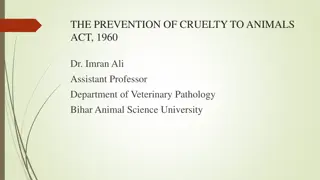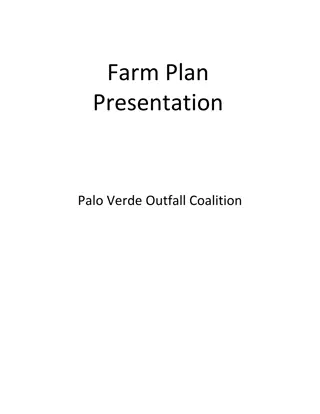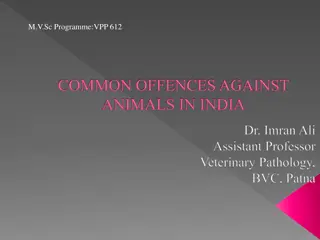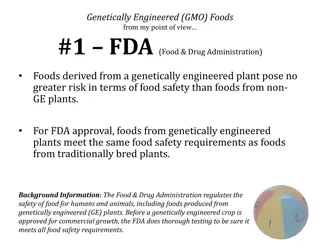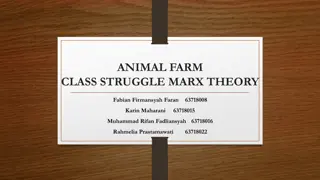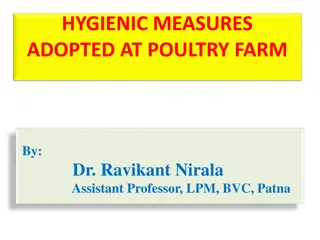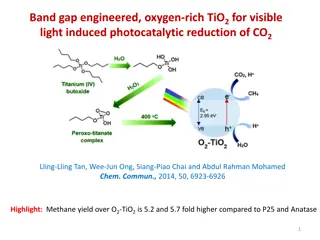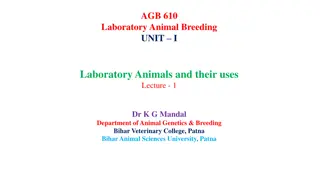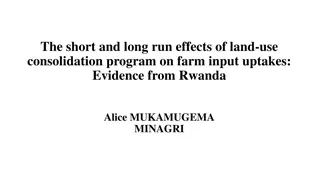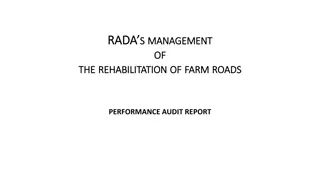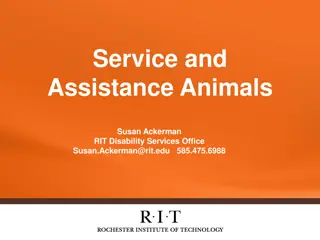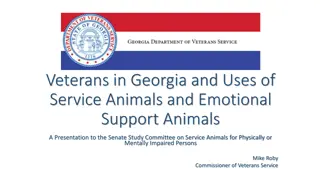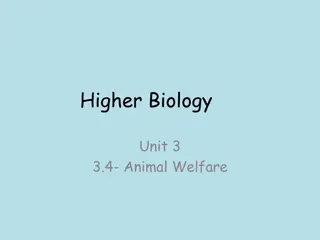Training Module on Genetically-Engineered Farm Animals
This training module provides essential information on genetically-engineered farm animals, including welfare considerations, ethical care requirements, and potential impacts of genetic engineering. It covers a range of topics such as regulations, welfare issues, and special considerations for care and nutrition alterations. Explore the definition of GE animals, factors compromising their welfare, and the goals of the module to enhance understanding and promote ethical practices in working with such animals.
Download Presentation

Please find below an Image/Link to download the presentation.
The content on the website is provided AS IS for your information and personal use only. It may not be sold, licensed, or shared on other websites without obtaining consent from the author.If you encounter any issues during the download, it is possible that the publisher has removed the file from their server.
You are allowed to download the files provided on this website for personal or commercial use, subject to the condition that they are used lawfully. All files are the property of their respective owners.
The content on the website is provided AS IS for your information and personal use only. It may not be sold, licensed, or shared on other websites without obtaining consent from the author.
E N D
Presentation Transcript
CCAC TRAINING MODULE ON: GENETICALLY-ENGINEERED FARM ANIMALS www.ccac.ca
Relevance of this Training Module This training module is relevant to all animal users working with genetically-engineered (GE) farm animals in research, teaching or testing. This module covers the following GE farm animals: dairy and beef cattle sheep goats swine poultry horses farmed wildlife Photo courtesy of Animal Resources Centre, University of Saskatchewan 2
Training Module Goals Introduce the issues related to the impacts of genetic engineering on farm animals Provide an appreciation for the special care requirements of GE farm animals Provide investigators with references and resources for the ethical care and use of GE farm animals in science Basic principles of farm animal welfare, fundamental needs, acquisition, routine handling and specialized procedures and termination of scientific use are covered in the CCAC training module on: the ethical use and care of farm animals in science (2010) 3
Training Module Outline Overview of GE farm animals Welfare issues Regulations Special considerations for potential alterations in care and nutrition 4
Definition of Genetically-Engineered Animals GE animals have a random or targeted genetic change due to deliberate human technological intervention Special considerations: unexpected welfare impacts ethical concerns risk to humans, environment, etc. Photo courtesy of Dr. C. Forsberg Pronuclear microinjection of embryos See the CCAC guidelines on: genetically-engineered animals used in science (in prep.) for further information 5
Factors Compromising the Welfare of Genetically-Engineered Farm Animals Many potential issues may arise from genetic engineering; a few examples: high stillborn rates low short-term survival rates chronic long-term health issues developmental issues physiological abnormalities Ultrasound scanning Investigators should be aware that in addition to the intended effects of genetic engineering (e.g., deliberate production of diseases or gene function abnormalities), unintended effects are also likely 6
Regulations Additional regulations for GE animals, as well as their progeny and products (e.g., new substances , novel feeds ) Environmental release and indirect human health impacts of new substances regulated by Environment Canada and Health Canada under the Canadian Environmental Protection Act, 1999 (CEPA) Animal Feed Division of Canadian Food Inspection Agency requires safety assessment of novel feeds : livestock humans (worker/bystander exposure and consumption of products) environment 7
Identification & Tracking Two separate forms of identification should be used for GE farm animals: permanent (e.g., microchip or tattoo) easy to identify and read (e.g., ear tag) Records outlining the specifics of any genetic modification are necessary and: facilitate accurate follow-up care for health and welfare should be in accordance with regulatory agency and institutional requirements 8
Transport In addition to following species-specific guidelines, special consideration should be given to: biosecurity measures to prevent accidental release of genetically-engineered farm animals (e.g., transporting such animals separately from conventional farm animals) physiological impact of any genetic modifications (e.g., immunosuppression) Photo courtesy of Agriculture and Agri-Food Canada 9
Confinement At least two physical barriers should be used when confining GE farm animals Maintain secure confinement limit access to authorized personnel only screen and log all visitors and vehicles adhere to any additional regulations 10
Care & Nutrition Providing care tailored to the special needs of GE farm animals is important for both good animal welfare and for achieving scientific goals higher levels of monitoring required to identify unanticipated welfare concerns Care and nutrition of GE farm animals will be heavily dependent on the: impact of specific genetic engineering methods (e.g., a transgene introduced may alter physiology) intended end use of animals or their products 11
Example of Potential Impact of Genetic Engineering: Nutrient Requirements Changes Physiological pathways altered by genetic modification Changes in digestion and absorption and utilization of nutrients Potential deficiencies and toxicities e.g., animals kept indoors may require Vitamin D supplementation 12
Example of Potential Impact of End Use: Feeding Regimes Considering the intended end use of GE farm animals will help dictate any necessary changes to feeding regime Alteration to conventional feeding practices (e.g., pesticide- free feed to animals producing pharmaceuticals in their milk) Offspring of animals used for producing products within their milk will need adapted feeding programs Photo courtesy of UBC Animal Welfare Program 13
Ensuring Optimal Care Systematic welfare assessment helps to identify potential effects of genetic engineering on physiological and behavioural states Potential indicators of issues: changes in behaviour abnormal physical changes Photo courtesy of Dr. C. Forsberg Three grower hemizygous Enviropigs
Ensuring Optimal Care Careful observation helps mitigate adverse welfare consequences by: revealing special needs and/or problems stemming from specific genetic engineering methods developing special care methods for animals in the same applications determining relevant endpoints See the CCAC guidelines on: choosing an appropriate endpoint in experiments using animals for research, teaching and testing (1998) and the CCAC training module on: pain, distress and endpoints (2010) for further information regarding endpoints
Summary Genetic engineering may have adverse effects on farm animals Special consideration should be given to: regulations, identification and transportation meeting special care and nutrition needs of the GE farm animals based on the specific modifications made, as well as the intended end use of the animals Paying attention to the special needs of GE farm animals will result in improved scientific outcomes Investigators should strive to achieve their scientific goals in line with the best possible animal welfare standards 16
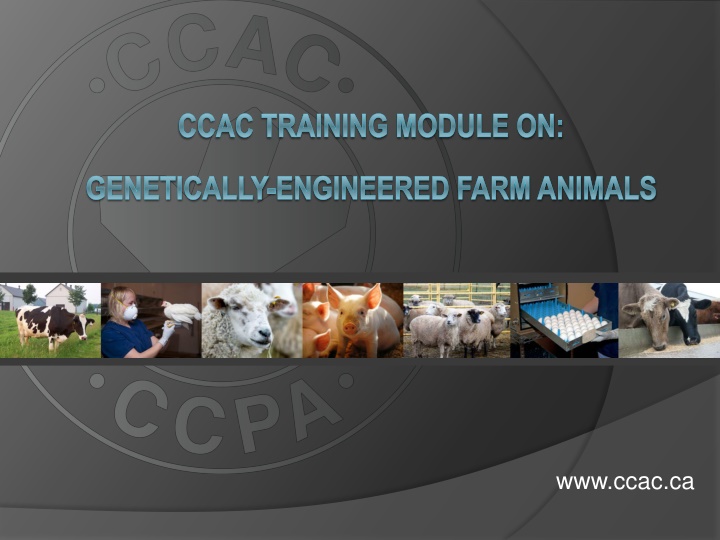

![❤[PDF]⚡ Escaping from Eden: Does Genesis Teach that the Human Race was Created](/thumb/21697/pdf-escaping-from-eden-does-genesis-teach-that-the-human-race-was-created.jpg)


